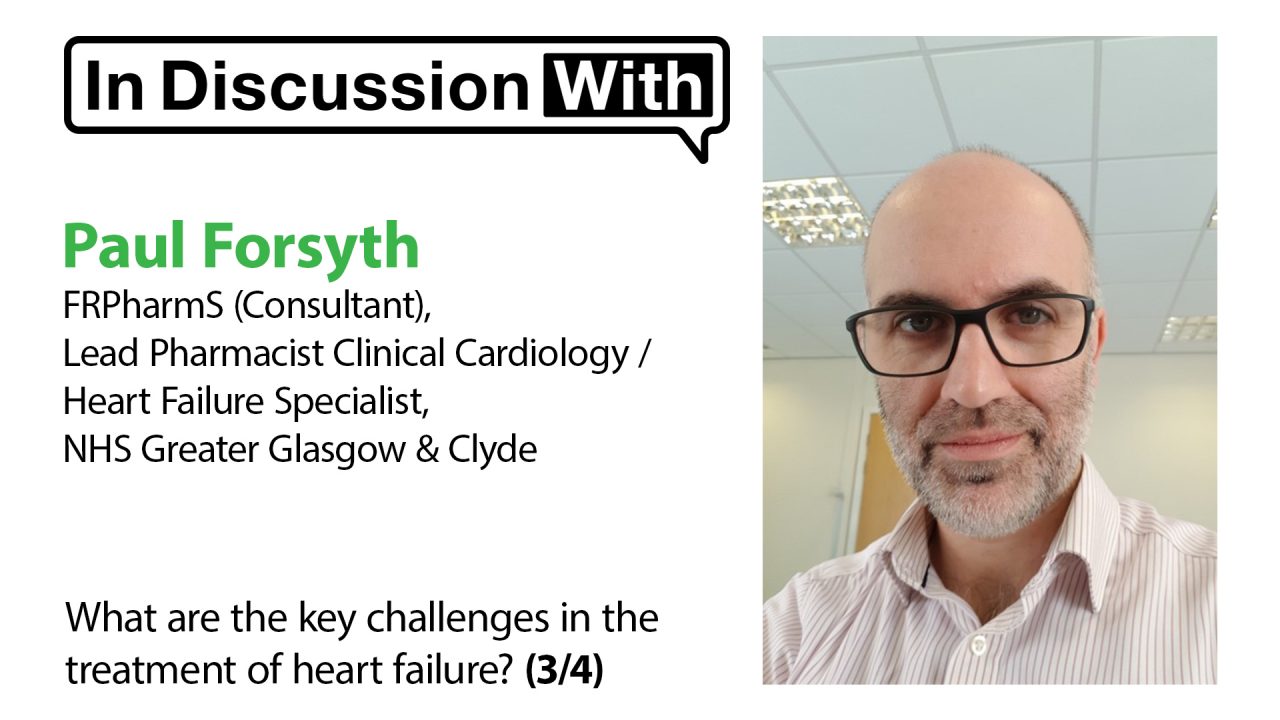What are the key challenges in the treatment of heart failure?

The key challenges in heart failure treatment include reaching the target dose, awareness of drug-specific issues that influence effectiveness and tackling adherence problems, according to Paul Forsyth, Lead Pharmacist, Clinical Cardiology at NHS Greater Glasgow and Clyde.
Quadruple therapy with the ‘four pillars’ of treatment – a renin-angiotensin system inhibitor (RASi), a beta-blockers, a mineralocorticoid agonist (MRA), and a sodium-glucose co-transporter 2 inhibitor (SGLT2i) is now advocated for the treatment of heart failure. Reaching the target dose for each pillar is an important part of effective treatment. “For three of the four pillars we normally start below the target dose then we have to build them up. ….. We have a starting dose and then a target dose that we’re trying slowly to get to – so …… you might start on a quarter of the target dose and then maybe go up after a couple of weeks or a month to a half a target dose and then eventually to the full target dose”, explains Mr Forsyth. For SGLT2 inhibitors there is only one dose and so patients start on the optimal dose, he notes. Individualising doses is important because “heart failure doesn’t just happen in old patients”, he says. Patients with heart failure can range from “very young, robust people to very elderly frail people – and not all of them can tolerate a full adult target dose”, he says.
Drug specific considerations
Variations in the responses to drug therapy can occur because of the intrinsic properties of the drugs and/or because of differences in the ways that individuals absorb, metabolise and excrete drugs.
Some drugs are water soluble some drugs are fat soluble; the way in which your body is made up ….. some people are obese, some people are very skeletal and thin – so where these drugs go in your body, how they’re distributed, how long they are retained within your body can be quite different from patient A to Patient B. How your body excretes them – metabolises them and passes them out of your body – are often affected by things like your liver and your kidney function. So, [these differences] might mean that and within a class of medicines you’re better looking at drug A rather than drug B”, says Mr Forsyth. Taking the example of beta blockers – “some are hydrophilic and some are lipophilic; some are very selective for certain receptors and reduce things like heart rate more than others, some are less selective. The side-effect profiles can be quite different because the lipophilic ones sometimes cross the blood-brain barrier and cause different types of side effects, so, again, you have to look at the patient in front of you. There might be a drug that is your kind of go-to drug if you’ve got no other great considerations but sometimes – and especially as you get more elderly – we have to try different combinations or different drugs within a class, he explains
Other factors that also need to be taken into consideration include the available evidence for effectiveness and the side effects profiles of the different drugs within the same class. For example, trials for spironolactone and eplerenone used different cohorts of patients – “quite symptomatic patients for spironolactone one in less symptomatic patients or post-myocardial infarction patients for eplerenone”, says Mr Forsyth. In addition, the side effects profiles differ; spironolactone is associated with gynaecomastia but eplerenone is not. “It’s always the same, you treat the patient in front of you and you have to tailor the choice of the agent to the characteristics of that patient”, he emphasises.
Adherence
Adherence can be a problem but it is a complicated, multi-factorial phenomenon. The notion that the doctor or health professional tells the patient what to do and the patient follows the instructions to the letter is built on a number of assumptions “It assumes that you understand what’s wrong with you, you understand the instructions [and that] you understand the pros and cons [of the treatment]. It assumes that you want the treatment and you have some motivation to take it – you’ve chosen to take it.”, explains Mr Forsyth. It also assumes that there are no practical barriers to adherence. Mr Forsyth continues: “So the important thing with adherence is going back to basics [and asking], “Do people understand things and do they want the treatment?” …If the answer is ‘yes’ then we have to look for what’s stopping you. Is it something about your life? Is it something about cost? Is it something about another health conditions? Are you depressed? Are you cognitively impaired? Have you GI problems – are you vomiting things back up? Can you not read the labels? Do you speak in another language? Can you not understand the directions? “
The best way to tackle adherence problems is to speak to the patient and find out what the barriers are so that at individualised solution can be found, he concludes.
Read and watch the full series on our website or on YouTube.




